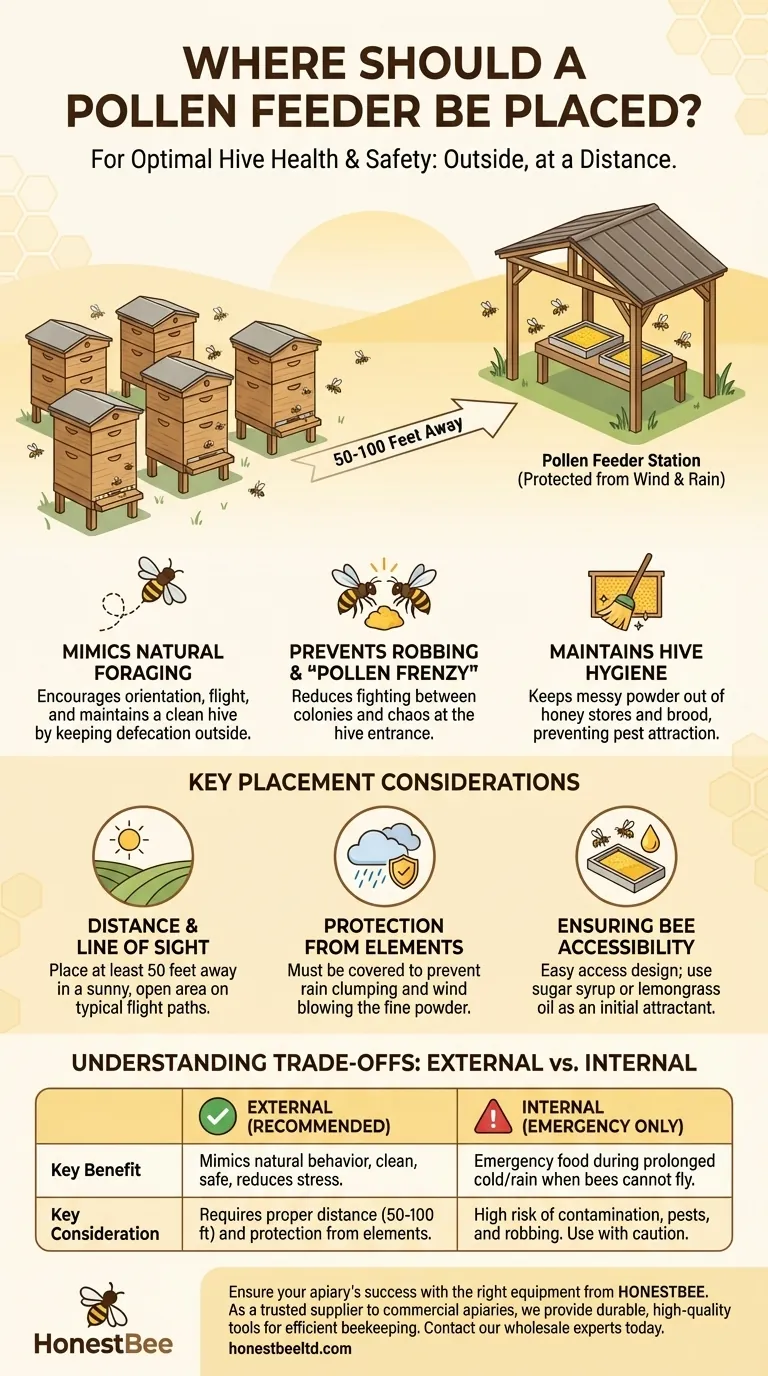For optimal hive health and safety, a pollen feeder should be placed outside the hive, at a distance, in a location that is easily accessible to your bees but protected from wind and rain. This strategy mimics natural foraging behavior and prevents potential issues like pest infestation and robbing by other colonies.
The core principle is to treat pollen substitutes like a natural nectar or pollen source. Placing the feeder away from the hive encourages bees to forage normally, reduces defensive behavior at the hive entrance, and maintains internal hive hygiene.

The Rationale for External Placement
Placing a pollen feeder inside the hive seems intuitive, but experienced beekeepers overwhelmingly favor an external, separate location. The reasoning is rooted in bee biology and hive management best practices.
Mimicking Natural Foraging
Bees are hardwired to fly out and search for resources. Placing a pollen feeder 50 to 100 feet away from the hive encourages them to engage in this natural orientation and foraging behavior.
This flight helps them maintain a clean hive, as they will often defecate during flight, away from the brood and food stores.
Preventing Robbing and "Pollen Frenzy"
A pollen source placed directly at or in the hive can trigger a chaotic rush. This can attract bees from other nearby hives, leading to a dangerous situation known as robbing, where colonies fight over the resource.
Separating the feeder from the hive diffuses this intensity, reducing the likelihood of bees fighting and creating a less stressful collection environment.
Maintaining Hive Hygiene
Dry pollen substitutes are a fine powder that can easily contaminate the hive, settling on honey stores and in brood cells. This mess is difficult for bees to clean up.
Keeping the supplement outside prevents this contamination and reduces the risk of attracting pests like small hive beetles or wax moths directly into the colony.
Key Placement Considerations
Where you place your external feeder is just as important as the decision to place it outside.
Distance and Line of Sight
Position the feeder a significant distance from your hives, ideally at least 50 feet. Place it in a sunny, open area that lies within their typical flight paths.
This makes it easy for them to find but keeps the feeding activity separate from the hive entrance.
Protection from the Elements
Pollen substitutes are useless once wet. Moisture causes clumping and mold, making the food unpalatable and potentially harmful.
Your feeder must have a cover to protect it from rain. It should also be shielded from strong winds that can blow the fine powder away. A dedicated feeding station or placement under an eave or other structure works well.
Ensuring Bee Accessibility
The feeder design should allow bees easy access to the pollen substitute without trapping them. Open tray-style feeders are common.
To help them find it initially, you can place a small amount of sugar syrup or a drop of lemongrass oil nearby as an attractant.
Understanding the Trade-offs: External vs. Internal
While external feeding is the standard recommendation, it's crucial to understand why internal feeding is sometimes considered and why it's usually avoided.
The Clear Advantage of External Feeding
This method is cleaner, safer, and more aligned with the bees' natural instincts. It minimizes stress on the colony and reduces the risk of disease and pest transmission associated with a messy internal food source.
The Limited Case for Internal Feeding
Some beekeepers might use an internal feeder during prolonged periods of cold or rain when bees cannot fly. This is an emergency measure, not a standard practice.
The significant downsides are the inevitable mess inside the hive and the increased risk of attracting pests. If you must feed internally, do so with extreme caution and for the shortest time possible.
Making the Right Choice for Your Apiary
Your goal is to supplement your bees' nutrition in a way that supports, rather than disrupts, their natural rhythms.
- If your primary focus is hive health and hygiene: Always choose an external feeder placed at a distance from the hive.
- If you are managing multiple colonies: A single, well-placed external feeder can serve the entire apiary, simplifying your workflow.
- If you are facing an emergency in a very weak hive with persistent bad weather: You may consider temporary internal feeding, but be vigilant about cleaning up and removing it as soon as conditions improve.
Ultimately, placing your pollen feeder properly is a simple step that supports the long-term strength and vitality of your colony.
Summary Table:
| Placement Location | Key Benefit | Key Consideration |
|---|---|---|
| External (Recommended) | Mimics natural foraging, prevents robbing, maintains hive hygiene. | Place 50-100 ft away, protect from rain/wind, ensure easy bee access. |
| Internal (Emergency Only) | Provides food during prolonged cold/rain when bees cannot fly. | High risk of hive contamination, pest attraction, and robbing. |
Ensure your apiary's success with the right equipment from HONESTBEE.
Proper feeding is just one part of a healthy operation. As a trusted supplier of beekeeping supplies and equipment to commercial apiaries and distributors, HONESTBEE provides the durable, high-quality tools you need for efficient and profitable beekeeping.
Let us help you build a stronger, more resilient operation. Contact our wholesale experts today to discuss your specific needs and discover how our products can support your success.
Visual Guide

Related Products
- Professional Hive Top Bee Feeder for Beekeeping
- HONESTBEE Professional Hive Top Bee Feeder Feeding Solution
- Rapid Bee Feeder White Plastic 2L Round Top Feeder for 8 or 10-Frame Bee Hives
- HONESTBEE Round Hive Top Bee Feeder for Syrup
- HONESTBEE Entrance Bee Feeder Professional Hive Nutrition Solution for Beekeeping
People Also Ask
- What are the features of top feeders for bees? Maximize Hive Health with Safe, High-Capacity Feeding
- How to use a top feeder in a beehive? A Guide to Effective Beehive Feeding
- What is a top feeder for bees? Maximize Colony Health with Efficient Feeding
- What are the advantages of using top feeders for bees? Maximize Feeding Efficiency & Colony Safety
- What are the advantages of hive top feeders? Maximize Feeding Efficiency for Your Apiary



















